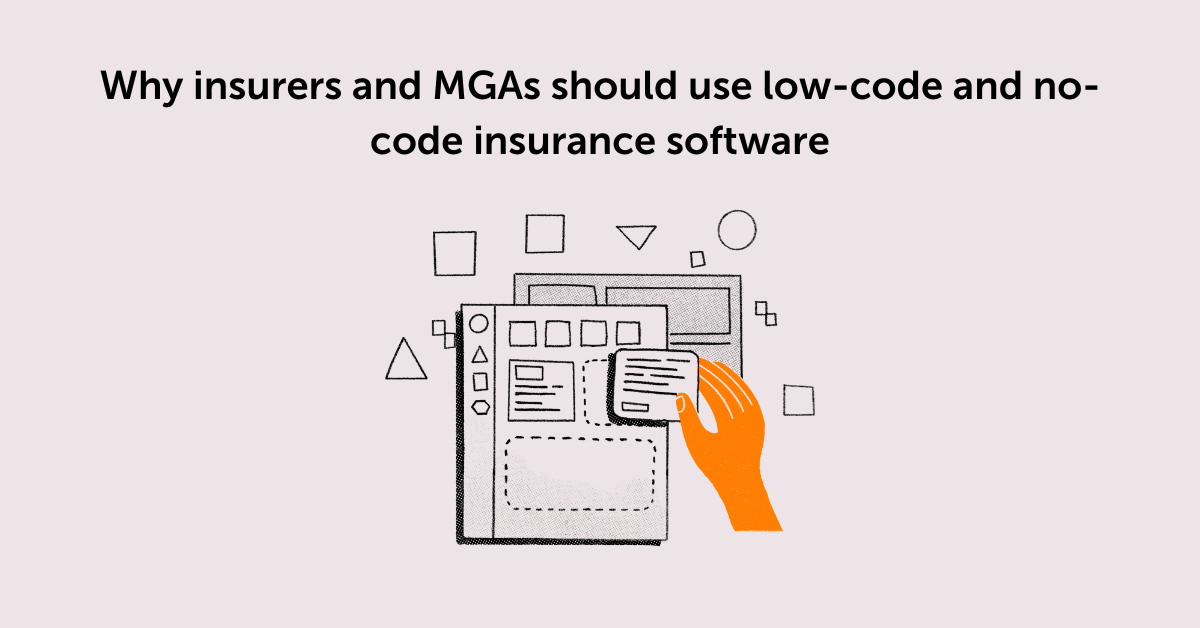Despite massive leaps forward in the technology landscape, research suggests that three-quarters of insurance companies still rely heavily on legacy systems. While understandable in days gone by, when building software required drawn-out development times and significant cost, today there is a much more straightforward and cost-effective solution: No-code and low-code software.
Low-code and no-code insurance software turn development from a complex and time-consuming coding marathon into a simple process with a fast delivery cycle. They mean that building software no longer requires coding knowledge or even IT experience. Instead, anybody from within a business can build the applications they need to automate and streamline how they work.
The popularity of these tools is growing all the time. The global low-code development platform market size was valued at USD 34.7 billion in 2024 and is projected to grow at a CAGR of 11.6% between 2025 and 2034. Furthermore, recent research found that 95% of companies have used low-code and no-code tools for software development in the past year, proving that these platforms are the driving force behind digital transformation.
For insurance businesses, low-code and no-code tools offer the perfect solution for modernising systems and streamlining processes, but without the financial and time investment of building software from scratch. No-code and low-code development platforms are ideal for automation across the entire insurance lifecycle, from quote and bind through to configuring policy administration systems and building reports.
Here is a quick overview of the difference between the two approaches, followed by a more detailed overview of the benefits.
Low-code insurance software
Low-code insurance software enables businesses to create applications quickly, with minimal handwritten code. Providing visual development tools, basic code, and integrations, these platforms enable insurers and MGAs to build applications without developing complicated infrastructures, cutting the development cycle down to days or hours.
Unlike no-code tools, low-code platforms do still presume some programming knowledge for creating applications and products. As a result, they may not suit a business with little development expertise at their disposal. Although in some cases, the platform provider will be on hand to help where coding is required. The flipside of this is that low-code tools offer greater flexibility and functionality based on the ability to customise code.
No-code insurance software
In contrast, no-code insurance software doesn’t assume any sort of programming knowledge for building products. It works via a drag-and-drop interface where existing code blocks can be placed into a workflow to quickly assemble and design applications. Everything an MGA or insurance company needs for product creation is built into the platform, so, instead of coding skills, you simply need to know how your product is created.
As a result, no-code insurance software allows less functionality and customisation than low-code. Instead, it offers tools to rapidly organise information rather than modify unique code. No-code products are, above all, meant for the quick design of apps and business processes at a large scale.
|
Feature |
Low-code |
No-code |
|
Meant for |
Developers |
Business and non-tech users |
|
Main Objective |
Development speed |
Ease of use |
|
Coding Requirement |
Low |
None |
|
Customisation |
Totally customisable |
Pre-built templates customisable |
|
Application complexity |
Create complex apps |
Create simple apps |
Five benefits of low-code and no-code insurance software for insurers and MGAs
No-code and low-code software have created opportunities for insurers and MGAs to adapt to constantly changing environments, giving them the agility to create new products with ease and modify existing products conveniently. None of this is possible with outdated legacy systems.
Key benefits include the following:
Faster product development and build. Instead of coding skills being a must to create insurance products, these simple drag-and-drop solutions enable insurers and MGAs to significantly accelerate their prototyping and product development timelines. As a result, they can respond more rapidly to a changing business landscape and iterate based on feedback and market changes.
Flexible and modular approach. No-code and low-code software can be enriched with different features and integrations, allowing insurers and MGAs to design, develop, and deploy products and services that seamlessly merge into insurance processes. For example, adding a new claims or accounting module is simple.
Integrating with other IT systems. These solutions connect to existing software, hassle-free, enabling smooth process automation and improved data oversight. For example, a low-code or no-code insurance platform can be easily integrated with accounting or CRM software to get a comprehensive overview of a customer’s background.
Saving IT and operational costs. Launching and running products on no-code and low-code platforms doesn’t require constant development costs as for monolithic core systems, nor specific IT skills or resources of programmers or developers. Fewer inefficiencies due to automated processes cut operational costs of fixing errors and making updates, freeing IT staff for more complex work.
Gradual digital transformation. The flexibility of no-code and low-code tools allows insurers and MGAs to update their systems and processes gradually, rather than overhauling the whole infrastructure in one go. This makes it far easier to manage the financial and resource investment of digital transformation.
Insly’s low-code insurance software has been designed specifically for MGAs and insurers, with a high level of customisation to fit each business’s exact needs. But because it’s low code, it can be implemented in just a matter of weeks, rather than the months required to build software from scratch.
Don’t hesitate to get in touch if you would like further information.



